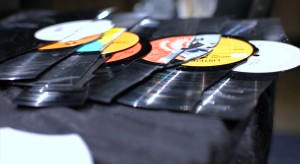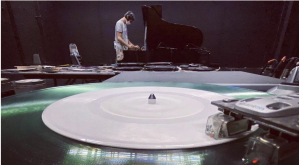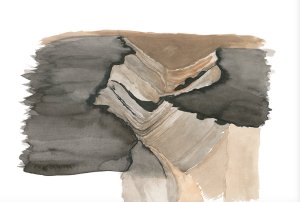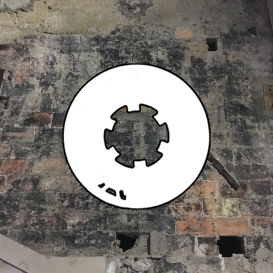
Maria Chavez is a pioneer of Abstract Turntablism, a self-described practice she developed under the guidance of Pauline Oliveros‘ Deep Listening. Born in Lima, Peru and raised in Houston, she cut her teeth as a DJ spinning techno and drum & bass, but the male chauvinism of that scene roused her to experiment further with the materiality of vinyl, using broken needles and non-musical sounds. Oliveros inspired her to ditch dance parties for improvisation with a single turntable, an artistic practice which has evolved to include installations, workshops, visual art, and curation. A true sound artist (she adamantly eschews the label “musician”), until recently, Chavez had released only one recording, 2004’s Those Eyes Of Hers, focusing instead on her career as longform performance. But after beginning a medical sabbatical in 2019, which forced her to cease touring (a year before the rest of the world shut down), Maria began slowly releasing new recordings into the world. In this episode, we discuss recent and upcoming collaborations, her switch to using four turntables (with double needles), and staking out her rightful place in art history contra White supremacist power structures.
Episode 24: KAKAPHONY
Sound Propositions should be available wherever you get your podcasts, so please keep an eye out and subscribe (and rate and review, it helps others who might be interested find us). You can support Sound Propositions on Patreon if you are so inclined, or send a one-time donation via PayPal. The first two seasons are also available on Bandcamp. I’m very grateful for any support, which will help ensure future episodes.
Interview recorded between New York and Montreal, January 2022
Produced and mixed in Montreal, April 2022
SP* at Anchor
 “What is the opposite of a DJ?” Chavez asked herself this question when first confronted with how to improvise as a turntablist. She settled on one turntable and one mixer, and an array of (oft-broken) needles and damaged records. [Insert bad Neil Young joke.] I first encountered Chavez’s work via her interview in Tara Rodgers’ Pink Noises (2010), where she relays her origin story: She began DJing at 16, starting a duo with her then-boyfriend spinning techno and dnb. She studied Art History at the University of Houston, while DJing at Rice University’s radio station. Frustrated with the lack of experimentation in DJ culture, she would attend jazz and improvised music concerts on Sundays. An encounter with Joe McPhee’s Trio X introduced her to avant-grade and improvised musics. Upon meeting David Dove, director of the Pauline Oliveros Foundation, she asked to intern. From Oliveros she learned to embrace silence, to resist the urge to fill all the sonic space. She instead began to think in terms of controlling mechanics, working with the chance breaks and shaping and sculpting the resultant sounds. She transferred to community college to study audio engineering, during which time she began attending Dove’s improvisation class at the Multicultural Educational Counseling through the Arts (MECA) organization as part of her internship. It was there, in a duo with Dove, that Chavez made her first attempt at improvising, using a single turntable and mixer. The success of that first attempt was a profound “whoa” moment, an epiphany that changed the course of her life.
“What is the opposite of a DJ?” Chavez asked herself this question when first confronted with how to improvise as a turntablist. She settled on one turntable and one mixer, and an array of (oft-broken) needles and damaged records. [Insert bad Neil Young joke.] I first encountered Chavez’s work via her interview in Tara Rodgers’ Pink Noises (2010), where she relays her origin story: She began DJing at 16, starting a duo with her then-boyfriend spinning techno and dnb. She studied Art History at the University of Houston, while DJing at Rice University’s radio station. Frustrated with the lack of experimentation in DJ culture, she would attend jazz and improvised music concerts on Sundays. An encounter with Joe McPhee’s Trio X introduced her to avant-grade and improvised musics. Upon meeting David Dove, director of the Pauline Oliveros Foundation, she asked to intern. From Oliveros she learned to embrace silence, to resist the urge to fill all the sonic space. She instead began to think in terms of controlling mechanics, working with the chance breaks and shaping and sculpting the resultant sounds. She transferred to community college to study audio engineering, during which time she began attending Dove’s improvisation class at the Multicultural Educational Counseling through the Arts (MECA) organization as part of her internship. It was there, in a duo with Dove, that Chavez made her first attempt at improvising, using a single turntable and mixer. The success of that first attempt was a profound “whoa” moment, an epiphany that changed the course of her life.
 Often the only woman in certain situations, Chavez resists being categorized as a “female musician,” or that her work sounds “feminine.” In fact, she resists referring to her work as “music” at all. Partly, it seems to me, this is out of respect for her collaborators, many of whom are trained musicians. She ends her interview in Pink Noises reflecting on the barriers presented to her as a woman, and as a Latina as well, compounded by the novelty of her approach to sound, playing a turntable in a way that’s distinct from DJing or turntablism conventionally understood. But she also notes that her mother describes her work as “the music of the future.” I myself would advocate a more expansive definition of what constitutes “music” beyond the conservative and authoritarian tradition of scored and notated European art music.
Often the only woman in certain situations, Chavez resists being categorized as a “female musician,” or that her work sounds “feminine.” In fact, she resists referring to her work as “music” at all. Partly, it seems to me, this is out of respect for her collaborators, many of whom are trained musicians. She ends her interview in Pink Noises reflecting on the barriers presented to her as a woman, and as a Latina as well, compounded by the novelty of her approach to sound, playing a turntable in a way that’s distinct from DJing or turntablism conventionally understood. But she also notes that her mother describes her work as “the music of the future.” I myself would advocate a more expansive definition of what constitutes “music” beyond the conservative and authoritarian tradition of scored and notated European art music.
 But Chavez’s refusal of music, and her embrace of sound, is what allowed her to develop her artistic practice, which she describes as Abstract Turntablism. That practice exceeds any one medium or performance practice, encompassing sound art, installations, pedagogy, and visual art. Long based in New York, she has collaborated with the Merce Cunningham Dance Company, and had work featured in many museums, including the Dia:Beacon and the Whitney. She has also performed and exhibited at festivals, museums, and galleries around the world. She has performed with many musicians, including Lydia Lunch, Christian Marclay, Thurston Moore, Phil Niblock, and Otomo Yoshihide, among many others. From February 1 until April 8 of this year, her “Paperworks, 2008-2022 (paper, sound, motion)” were on display at the Sheehan Gallery, a testament to how prolific her visual art practice has become. While painting might be considered a mute medium, Chavez renders vinyl grooves and needles into abstract landscapes.
But Chavez’s refusal of music, and her embrace of sound, is what allowed her to develop her artistic practice, which she describes as Abstract Turntablism. That practice exceeds any one medium or performance practice, encompassing sound art, installations, pedagogy, and visual art. Long based in New York, she has collaborated with the Merce Cunningham Dance Company, and had work featured in many museums, including the Dia:Beacon and the Whitney. She has also performed and exhibited at festivals, museums, and galleries around the world. She has performed with many musicians, including Lydia Lunch, Christian Marclay, Thurston Moore, Phil Niblock, and Otomo Yoshihide, among many others. From February 1 until April 8 of this year, her “Paperworks, 2008-2022 (paper, sound, motion)” were on display at the Sheehan Gallery, a testament to how prolific her visual art practice has become. While painting might be considered a mute medium, Chavez renders vinyl grooves and needles into abstract landscapes.
 Records break in their own unique ways, as do needles. In the early days she preferred the Ortofon stylus, which she boasted she could use in a dozen performances before they would break. Focusing on sound and silence, on chance, Chavez developed a practice rich in subtlety and nuance, working with the imperfections of her materials. Each broken record and needle brings its own agency into the work. Chavez built up a body of records she would work with, mostly foley sound and test records used to calibrate hi-fi equipment, as well as field-recordings and other non-musical records, though she is always cycling in new records, sometimes altered in various ways. Unlike traditional DJs, she’s not interested in the recognizability of her sounds, and in fact actively avoids recognizable sounds. Her performances are run like workshops, encouraging dialogue with the audience. In our conversation she remembers two particularly memorable instances of audience participation: playing with a baby in Vancouver and a howling dog in Toronto. Chavez collected her years of insight into Of Technique: Chance Procedures on Turntable (2012), sharing her techniques with any who may be interested.
Records break in their own unique ways, as do needles. In the early days she preferred the Ortofon stylus, which she boasted she could use in a dozen performances before they would break. Focusing on sound and silence, on chance, Chavez developed a practice rich in subtlety and nuance, working with the imperfections of her materials. Each broken record and needle brings its own agency into the work. Chavez built up a body of records she would work with, mostly foley sound and test records used to calibrate hi-fi equipment, as well as field-recordings and other non-musical records, though she is always cycling in new records, sometimes altered in various ways. Unlike traditional DJs, she’s not interested in the recognizability of her sounds, and in fact actively avoids recognizable sounds. Her performances are run like workshops, encouraging dialogue with the audience. In our conversation she remembers two particularly memorable instances of audience participation: playing with a baby in Vancouver and a howling dog in Toronto. Chavez collected her years of insight into Of Technique: Chance Procedures on Turntable (2012), sharing her techniques with any who may be interested.
 One of the many lessons she learned from Pauline Oliveros was to be open to sound. Another was radical inclusivity and anti-capitalism. Rather than hiding her techniques behind a cloud of secrecy, she shares them. But she played with scarcity in other ways. After the release of Those Eyes of Her in 2004, she didn’t release another until Maria Chavez Plays (Stefan Goldmann’s ‘Ghost Hemiola’) in 2019. This meant that to experience her work, one had to seek out her performances. This changed when she began a medical sabbatical following a lifesaving brain surgery in February 2019. (She plans to finally return to touring in 2023.) And then the pandemic hit, and suddenly the entire world seemed to be reassessing how to organize events. Chavez argues that we must all learn from these experiences, and demand a radical inclusivity going forward, making sure that concerts are accessible to all.
One of the many lessons she learned from Pauline Oliveros was to be open to sound. Another was radical inclusivity and anti-capitalism. Rather than hiding her techniques behind a cloud of secrecy, she shares them. But she played with scarcity in other ways. After the release of Those Eyes of Her in 2004, she didn’t release another until Maria Chavez Plays (Stefan Goldmann’s ‘Ghost Hemiola’) in 2019. This meant that to experience her work, one had to seek out her performances. This changed when she began a medical sabbatical following a lifesaving brain surgery in February 2019. (She plans to finally return to touring in 2023.) And then the pandemic hit, and suddenly the entire world seemed to be reassessing how to organize events. Chavez argues that we must all learn from these experiences, and demand a radical inclusivity going forward, making sure that concerts are accessible to all.
 Even before her brain surgery, Chavez had a deep interest in neuroplasticity, and the ways in which arts and culture shape our perception of reality. In a recent essay, “Too Much Reality,” (e-flux, 2021), she described how activities produce new neural connections, and thus “can be trained and optimized through things like physical exercise, learning a new language, or working on a puzzle. Over generations, activities that evolve our brains take the form of culture.” This insight may help us move beyond the materialism/idealism binary. Material practices change how we think, literally, and so as ideas are made material in culture, our ideas are also shaped by material reality. Importantly, our perception of matter changes depending on our ideological lens. So Chavez takes neuroplasticity into account with her work, particularly what she has termed her Hyper Memory Installations” (HMI), in which she creates layered assemblages (often of the same field recordings) in order to create a density of sound that engenders specific physical reactions. She writes, “The experiential density of these ‘hypermnemonic’ installations has the potential to support and aid in developing neuroplasticity.”
Even before her brain surgery, Chavez had a deep interest in neuroplasticity, and the ways in which arts and culture shape our perception of reality. In a recent essay, “Too Much Reality,” (e-flux, 2021), she described how activities produce new neural connections, and thus “can be trained and optimized through things like physical exercise, learning a new language, or working on a puzzle. Over generations, activities that evolve our brains take the form of culture.” This insight may help us move beyond the materialism/idealism binary. Material practices change how we think, literally, and so as ideas are made material in culture, our ideas are also shaped by material reality. Importantly, our perception of matter changes depending on our ideological lens. So Chavez takes neuroplasticity into account with her work, particularly what she has termed her Hyper Memory Installations” (HMI), in which she creates layered assemblages (often of the same field recordings) in order to create a density of sound that engenders specific physical reactions. She writes, “The experiential density of these ‘hypermnemonic’ installations has the potential to support and aid in developing neuroplasticity.”
She first developed these ideas when working on her series The Rain of Applause (2012-present), which began when she was commissioned to realize a sound installation in Malmö, Sweden. In this episode, she describes her thought process during the development of that work. There will be performances happening in every city in the world any night of the week, and those performances will be met with some kind of applause; the enthusiastic cheering of the crowd, the polite applause of the staff, and so on. For The Rain of Applause, Chavez asks her hosts to record all the applause in their venue in the weeks or months leading up to her arrival, which she then edits into a dense Hyper Memory Installation. The abnormally long exposure to applause has a disorienting effect, a powerful subversion of a performance ritual of audience participation that is ubiquitous yet often goes without attentive listening.
The seventh version of The Rain of Applause was culled from recordings made during “Black Lives Matter marches, vigils and other events” during the summer of 2020, released as the final piece of Erstwhile Records’ AMPLIFY 2020 Festival. We at ACL found this entry particularly powerful, one of our favorite field-recording based works of 2020. Richard Allen wrote at the time that:
Chavez captures the energy, vitality, youth and unity of this worldwide movement, proclaiming its positivity through the meeting of palms. The topic is personal for the artist, who was once unjustly prisoned in Houston; the time of the soundscape (8:46) is a direct reference to George Floyd’s murder. The cheer of bicycle bells and car toots (as opposed to long honks) is evidence of empathy in a damaged time.
 In recent years, Chavez has begun performing with a new setup, using four turntables each equipped with RAKE double-headed needles and two mixers, each needle with its own dedicated channel. She designed these needles in collaboration with Randal Sandan Jr., and hopes that they might be commercially available in the future, and anticipated needing to update her book with these new techniques. This new rig also makes possible such a density of sound that she can now perform “live” versions of her Hyper Memory Installations. For instance, a recent performance for the Gray Center in Chicago sees her layering a variety of mostly nature recordings selected from the Folkways Records catalog.
In recent years, Chavez has begun performing with a new setup, using four turntables each equipped with RAKE double-headed needles and two mixers, each needle with its own dedicated channel. She designed these needles in collaboration with Randal Sandan Jr., and hopes that they might be commercially available in the future, and anticipated needing to update her book with these new techniques. This new rig also makes possible such a density of sound that she can now perform “live” versions of her Hyper Memory Installations. For instance, a recent performance for the Gray Center in Chicago sees her layering a variety of mostly nature recordings selected from the Folkways Records catalog.
 Many other recordings have seen release following Chavez’s surgery, each unique. Plays finds Chavez manipulating empty locked grooves from Stefan Goldmann‘s double-vinyl Ghost Hemiola. With no explicit content of its own, Plays reveals Chavez’s technique at its most pure, a deep exploration of the materiality of vinyl, even when it is empty save for a locked groove. Chavez manipulates these grooves in a way that recalls electroacoustic glitch at its most minimalist. Chavez has also released three lovely recordings via her Bandcamp, collecting performances she gave during a residency at the Experimental Media and Performing Arts Center (EMPAC) at Rensselaer Polytechnic Institute, the institution where her late teacher Pauline Oliveros ended her storied career. I drew on many excerpts from those recordings for this episode, as well as recently released recordings of her duos with Lucas Gorham and Jordi Wheeler. Later this year we can also expect a limited lathe art series produced with Devin Kkenny, as well as a new collaboration with Sandy Ewen. What else does Maria have in store post-brain surgery? Stay tuned.
Many other recordings have seen release following Chavez’s surgery, each unique. Plays finds Chavez manipulating empty locked grooves from Stefan Goldmann‘s double-vinyl Ghost Hemiola. With no explicit content of its own, Plays reveals Chavez’s technique at its most pure, a deep exploration of the materiality of vinyl, even when it is empty save for a locked groove. Chavez manipulates these grooves in a way that recalls electroacoustic glitch at its most minimalist. Chavez has also released three lovely recordings via her Bandcamp, collecting performances she gave during a residency at the Experimental Media and Performing Arts Center (EMPAC) at Rensselaer Polytechnic Institute, the institution where her late teacher Pauline Oliveros ended her storied career. I drew on many excerpts from those recordings for this episode, as well as recently released recordings of her duos with Lucas Gorham and Jordi Wheeler. Later this year we can also expect a limited lathe art series produced with Devin Kkenny, as well as a new collaboration with Sandy Ewen. What else does Maria have in store post-brain surgery? Stay tuned.
 LINKS
LINKS
Maria Chavez
Bandcamp
EMPAC
Deep Listening
The Kitchen
Takuroku
TRACKLIST
ARTIST – “TITLE” (ALBUM, LABEL, YEAR)
Maria Chavez – “I Love You, 2020” (EMPAC SESSIONS: 3, 2020)
SP INTRO
Maria Chavez – “EMPAC SESSIONS: 2, 2020” (EMPAC SESSIONS: 2, 2020)
Beethoven / Werner Elmker – “Slow version of Für Elise” (YouTube, 2021)
Maria Chavez & Jordi Wheeler – “Five Thousand” (The Kitchen Sessions: 1-5, 2020, Takuroku, 2021)
Maria Chavez & Lucas Gorham – “A Side” (Live At Jewel’s Catch One, Ratskin, 2020)
Pauline Oliveros, Stuart Dempster, Panaiotis – “Nike” (Deep Listening, New Albion, 1989)
Devin KKenny – “NY Lottery-CBD Kratom (LALIT Remix)” (NY LOTTERY – CBD KRATOM, PTP, 2021)
DJ Screw / UGK – “Tell Me Something Good” (Bigtyme Vol II All Screwed U, Bigtyme Recordz, 1995)
DJ Screw – “Untitled [excerpt] (instrumental)” (June 27, Screwed Up Click Entertainment, 2004)
Annea Lockwood performed by Maze – “Bayou-borne, For Pauline” (Bayou-Borne / Jitterbug, MFR Contemporary Series, 2022)
Maria Chavez – “EMPAC SESSIONS: 1 (excerpt)” (EMPAC SESSIONS: 1, 2020)
Grandmaster Flash – [excerpt from the film] (Wild Style, 1982)
Geto Boys – “Still (Instrumental)” (The World Is A Ghetto, Noo Trybe Records, 1996)
Maria Chavez – [Excerpt] (Maria’s Last Live DJ set in Europe, Brussels, Saturday Night Radio Panik & Moacrealsloa, Jan. 2019)
Maria Chavez – “EMPAC SESSIONS: 1 (excerpt)” (EMPAC SESSIONS: 1, 2020)
Maria Chavez – “Guitar Vocabulary” (EMPAC SESSIONS: 2, 2020)
Maria Chavez & Jordi Wheeler – “Que Te Vaya Bien” (The Kitchen Sessions: 1-5, 2020, Takuroku, 2021)
Maria Chavez – [excerpt] (SquareWheels – DJ Mix, 1998)
Pauline Oliveros – “Big Mother Is Watching You” (Electronic Works 1965-1966, Paradigm Discs, 1997)
Grand Wizard Theodore and Mean Gene – [excerpt] (Live on 3rd Avenue Ballroom, 1977)
Pauline Oliveros & Cecil Taylor – “Duo” (Solo • Duo • Poetry, EMPAC Rensselaer, 2012)
Bernhard Leitner – “HT_A” (Kopfräume / Headscapes, Hatje Cantz, 2003)
Pauline Oliveros & Cecil Taylor – “Duo” (Solo • Duo • Poetry, EMPAC Rensselaer, 2012)
Maria Chavez – “Sara Sleeps, 2020” (EMPAC SESSIONS: 1, 2020)

Maria Chavez – “The Rain of Applause” (The Rain of Applause, Amplify, 2020)
Susanna Hood & Martin Tétreault – “Hello étendues” (Tortues vapeur, Mikroclimat, 2019)
Maria Chavez – “XI” (Maria Chavez Plays (Stefan Goldmann’s ‘Ghost Hemiola’), Macro, 2019)
Pauline Oliveros – “Bye Bye Butterfly” (Electronic Works 1965-1966, Paradigm Discs, 1997)
Antipop Consortium – “Volcano (Four Tet Remix Instrumental)” (Volcano, Big Dada, 2009)
—-
Sound Propositions is written, recorded, mixed, and produced by Joseph Sannicandro.
Source link
